Your interventional suite demands absolute precision. Using a standard display obscures vital details, compromising patient outcomes and increasing procedural risk. The right medical monitor transforms surgical visualization.
Medical displays are essential in interventional surgery rooms. They provide high-resolution imaging, multi-modality support, and low-latency performance. These features are critical for guiding minimally invasive procedures, improving team collaboration, and ensuring patient safety in sterile environments.
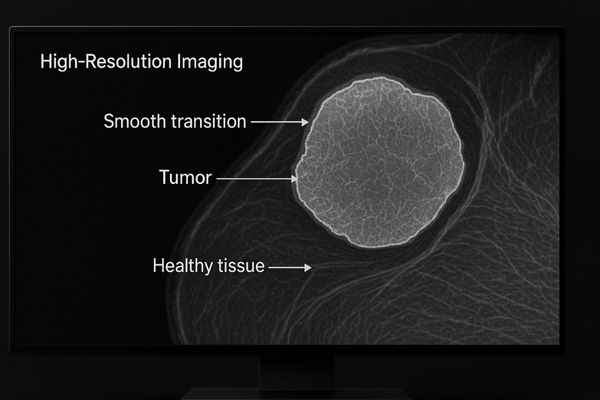
The modern interventional suite is a high-tech environment where every component must perform flawlessly. The https://reshinmonitors.com/top-medical-display-manufacturers-2025/1 is at the center of this ecosystem, serving as the visual hub for the entire surgical team2. In the following sections, we will explore the specific display features that are most critical for success in these demanding procedures. We will look at resolution, imaging capabilities, screen size, performance, and design.
High-Resolution Displays Support Complex Procedures
In minimally invasive surgery, seeing fine anatomical details is non-negotiable. Standard resolution can obscure guidewires and vessel walls, risking procedural errors. High-resolution displays provide the necessary clarity.
High-resolution displays, such as 4K monitors, are crucial for complex interventional procedures. They render anatomical structures, catheters, and guidewires with exceptional detail. This clarity allows surgeons to navigate with greater confidence and precision, improving patient outcomes.
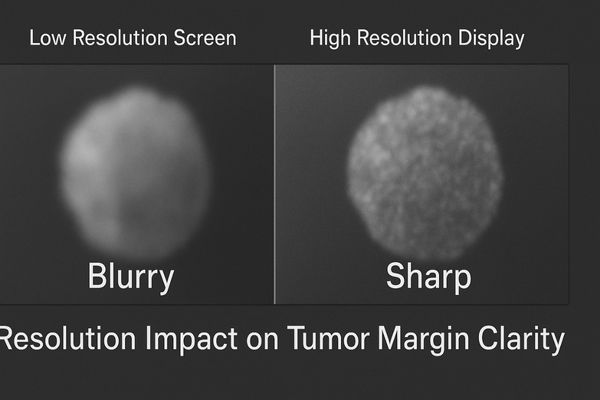
In interventional surgery, the display acts as the surgeon’s window into the patient’s body. The detail provided by this window can directly influence the success of a procedure. High-resolution imaging, particularly 4K3, is no longer a luxury; it is a clinical necessity. The increased pixel density allows for a much clearer depiction of fine structures like coronary arteries or cerebral vessels. Surgeons can more easily distinguish between tissue planes, identify the precise location of a lesion, and accurately guide micro-catheters. This level of detail is simply not available on older HD or FHD displays. For example, when deploying a stent, a 4K monitor provides a sharp, clear view of the stent struts as they expand against the vessel wall. This allows for precise placement and reduces the risk of malapposition. A large-format display like our MS550P – 55" 4K Surgical Monitor further enhances this by allowing surgeons to see these details from a comfortable distance, reducing eye fatigue during long and complex cases.
Multi-Modality Imaging Enhances Surgical Precision
Your team needs to view multiple imaging sources simultaneously. Constantly switching focus between different screens is inefficient and increases cognitive load. Multi-modality displays consolidate all data onto one screen.
Multi-modality imaging integration on a single display is key to surgical precision. It allows surgeons to overlay real-time fluoroscopy with pre-operative CT or MRI scans. This fusion of data provides a comprehensive anatomical roadmap, improving navigation and procedural accuracy.

The modern interventional suite relies on a fusion of information. Surgeons no longer depend on a single imaging source. Instead, they leverage multiple modalities to build a complete picture of the patient’s anatomy. A display capable of showing these sources simultaneously is therefore essential. Functions like Picture-in-Picture (PIP)4 and Picture-by-Picture (PBP) allow for flexible screen layouts. For instance, a surgeon performing a complex vascular procedure can view a live fluoroscopy image alongside a 3D-rendered CT angiogram and the patient’s real-time hemodynamic data. This integration provides a comprehensive operational map. Seeing the live catheter position overlaid on a static anatomical roadmap enhances precision and safety. Our MS430PC – 43" 4K Surgical Monitor5 is designed for these scenarios, offering multiple inputs and flexible layout options to support the complex visual needs of today’s hybrid operating rooms. This consolidation of data onto a single, large screen reduces clutter and helps the entire surgical team maintain situational awareness.
| Imaging Modality | Use in Interventional Procedures |
|---|---|
| Fluoroscopy | Real-time visualization of guidewires, catheters, and contrast agents. |
| CT/MRI Scans | Pre-operative anatomical planning and roadmap for navigation. |
| Intravascular Ultrasound (IVUS) | Detailed view inside blood vessels to assess plaque and stent placement. |
| Patient Vitals (ECG, BP) | Continuous monitoring of the patient’s physiological state. |
Large Screen Sizes Improve Team Collaboration
Your entire surgical team needs a clear view of the procedure. A small monitor creates blind spots and forces staff to crowd around. Large-screen displays ensure everyone stays informed.
Large medical displays, typically 43 inches or larger, improve team collaboration in the OR. They provide excellent visibility for the surgeon, assistants, nurses, and technicians from various positions around the room. This shared view enhances communication and coordinated action.
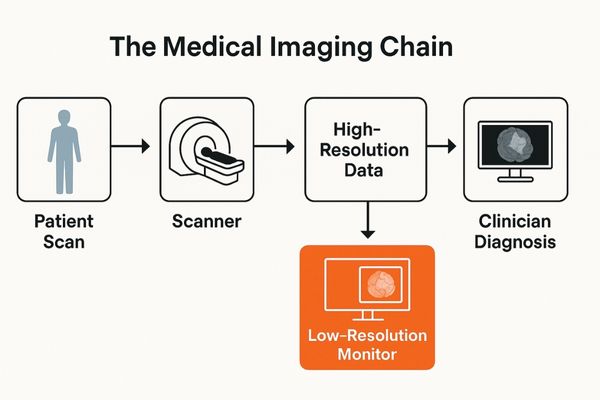
An interventional procedure is a team effort. The surgeon may be leading, but nurses, anesthesiologists, and radiologic technologists all play critical roles. Effective collaboration depends on shared information, and the primary source of visual information is the medical display6. A large screen ensures that every team member can see the same high-quality image without having to leave their station or crane their neck. This shared situational awareness is vital. For example, a nurse can anticipate the need for a specific catheter by watching its progress on the main screen. An anesthesiologist can correlate changes in patient vitals with specific moments in the procedure. Furthermore, wide viewing angles7 are just as important as screen size. A display must maintain its color and contrast accuracy even when viewed from the side. Our MS321PC – 32" 4K Surgical Monitor combines a generous screen size with a wide viewing angle, making it an ideal central display for many operating rooms and cath labs. This is also invaluable for teaching, allowing students and residents to observe procedures clearly.
Low Latency Performance Is Critical for Real-Time Guidance
You move a catheter, but the image on screen lags behind. This delay, or latency, can cause critical misplacements during delicate procedures. Low-latency displays provide instantaneous visual feedback.
Low latency is a critical safety feature in interventional surgery displays. It ensures that the image on the screen updates almost instantaneously with the surgeon’s actions. This real-time performance is essential for precise hand-eye coordination when navigating complex anatomy.
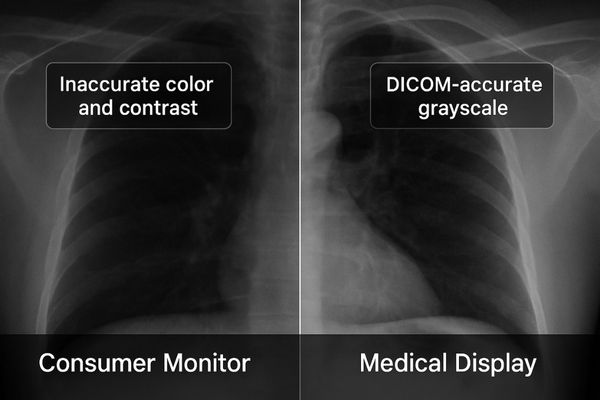
In interventional surgery, the surgeon’s hands and eyes must work in perfect synchrony. Latency, the tiny delay between when a signal is sent from an imaging source and when it appears on the display, can disrupt this synchronization. Even a delay of a few milliseconds can be perceptible and disorienting for a surgeon performing a high-precision task. Think of it like a video call with a bad connection; the lag between action and reaction makes fluid control impossible. In the operating room, this can lead to over-correction, where a surgeon pushes a guidewire too far because the visual feedback was delayed. This can result in vessel perforation or inaccurate stent deployment. Therefore, minimizing latency8 is a paramount design goal for any https://reshinmonitors.com/top-medical-display-manufacturers-2025/9. Our monitors, including the MS275P – 27" 4K Surgical Monitor, are engineered with advanced signal processing electronics to reduce this delay to an imperceptible level. This ensures that what the surgeon sees is a true, real-time reflection of what is happening inside the patient, providing the confidence needed for safe and effective procedures.
| Latency Level | Impact on Performance | Clinical Relevance |
|---|---|---|
| High (>50ms) | Noticeable lag, poor hand-eye coordination. | Unsafe for any real-time interventional guidance. |
| Moderate (20-50ms) | Slight disconnect, may cause over-correction. | Acceptable for static review, but not ideal for dynamic procedures. |
| Low (<20ms) | Imperceptible delay, feels instantaneous. | Essential for safe and precise control of catheters and guidewires. |
Sterile Design Features Meet Operating Room Standards
Your operating room requires a completely sterile environment. Traditional monitors with vents and seams are impossible to clean thoroughly, posing an infection risk. Sealed, fanless displays are designed for sterility.
Displays in interventional suites must have sterile design features. This includes a sealed, fanless construction, an IP rating for water resistance, and an anti-bacterial coating. These features prevent contamination and allow for fast, effective cleaning between procedures.
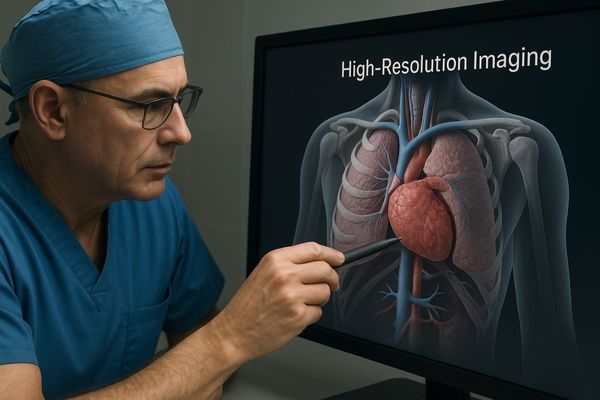
Infection control is a fundamental principle of any surgical environment. Every piece of equipment in the operating room must be designed to facilitate cleaning and prevent the buildup of contaminants. Medical displays are no exception. Standard commercial monitors are unsuitable for this environment because they often have cooling vents and plastic bezels with seams. These features can trap dust, fluids, and microorganisms, making proper sterilization impossible. In contrast, surgical displays10 are built with sterility in mind. They feature a fanless design, which prevents the circulation of airborne pathogens within the OR. The front surface is typically a single, seamless pane of glass that is sealed to the chassis. This design, often rated to IP65 for dust and water resistance11, allows staff to spray and wipe down the monitor with standard hospital-grade disinfectants without risking damage to the internal electronics. Our MS247SA – 24" FHD Endoscopic Monitor embodies these principles, with a sealed housing and durable front glass that meets the rigorous cleaning protocols of a modern interventional surgery room.
Conclusion
In interventional surgery, the right medical display is not just a screen. It is a vital tool that enhances precision, improves collaboration, and ensures patient safety in every procedure. To equip your interventional suite with advanced medical displays, contact Reshin at martin@reshinmonitors.com.
- Understanding the features of medical displays can enhance surgical outcomes and improve team efficiency. ↩
- Exploring how surgical teams leverage technology can provide insights into improving surgical practices and patient care. ↩
- Explore how 4K imaging enhances surgical precision and outcomes, making it essential for modern medical procedures. ↩
- Explore how PIP enhances surgical precision and efficiency by allowing simultaneous viewing of multiple images. ↩
- Learn about the superior image quality and detail that a 4K Surgical Monitor brings to complex surgical procedures. ↩
- Understanding the role of medical displays can enhance surgical teamwork and improve patient outcomes. ↩
- Exploring this topic reveals how wide viewing angles can improve collaboration and situational awareness in the operating room. ↩
- Explore this link to understand how minimizing latency can enhance surgical precision and safety. ↩
- This resource will guide you on essential features of surgical displays that improve surgical outcomes. ↩
- Explore how surgical displays enhance sterility and safety in medical settings, ensuring optimal patient care. ↩
- Understanding IP65 ratings can help you choose the right equipment for environments requiring high levels of protection. ↩


